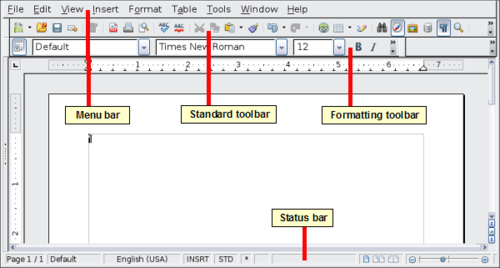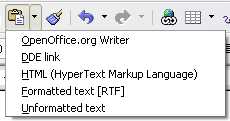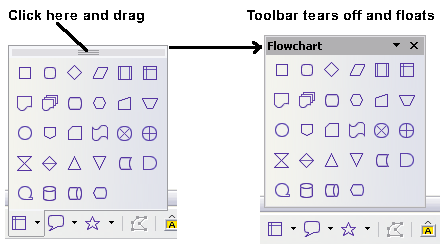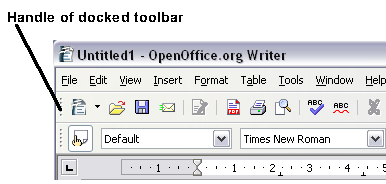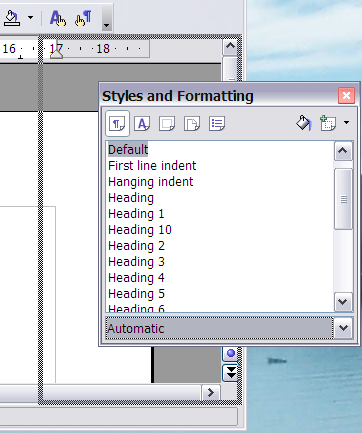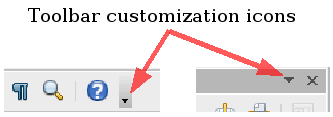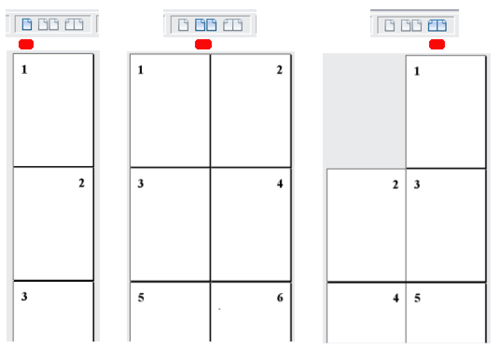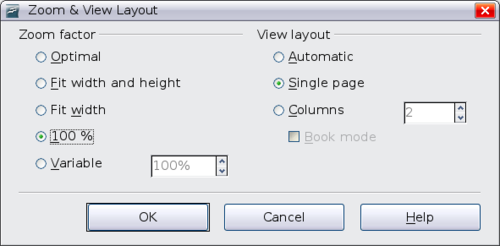Difference between revisions of "FR/Documentation/Writer Guide/Interface"
m (New page: {{DISPLAYTITLE:Documents Texte avec OpenOffice.org 3.x Writer}} {{Documentation/MasterTOC |ShowPrevNext=block |ShowPrevPage=block |ShowNextPage=block |booktitle=[[FR/Documentation/Writer_G...) |
m |
||
| Line 20: | Line 20: | ||
}}__NOTOC__ | }}__NOTOC__ | ||
| + | |||
| + | L'espace de travail principal de Writer est montré ci-dessous. | ||
| + | |||
| + | [[Image:Writer3-main.png|thumb|none|500px|''L'espace de travail principal de Writer en mise en page d'impression'']] | ||
| + | |||
| + | == Menus == | ||
| + | La '''barre de menu''' est située en haut de la fenêtre de Writer, juste en-dessous de la barre des titres. Lorsque vous choisissez l'un des menus, un sous menu se déploie pour afficher des commandes. | ||
| + | |||
| + | * '''Fichier''' contient des commandes qui s'appliquent à tout le document telles que '''Ouvrir''', '''Enregistrer''' et '''Exporter au format PDF'''. | ||
| + | * '''Édition''' contient des commandes pour éditer le document telles que '''Annuler''' et '''Rechercher & remplacer'''. | ||
| + | * '''Affichage''' contient des commandes pour contrôler l'affichage du document telles que '''Zoom''' et '''Mise en page Web'''. | ||
| + | * '''Insertion''' contient des commandes pour insérer des éléments dans le document telles que en-têtes, pieds de page et des images. | ||
| + | * '''Format''' contient des commandes pour formater la mise en page du document, telles que '''Style et formatage''', '''Paragraphe''' et '''Puces et numérotation'''. | ||
| + | * '''Tableau''' affiche toutes les commandes pour insérer et éditer un tableau dans un document texte. | ||
| + | * '''Outil''' contient des fonctions telles que '''Langue''', '''Personnaliser''' ou '''Options'''. | ||
| + | * '''Fenêtre''' contient des commandes pour la fenêtre d'affichage. | ||
| + | * '''Aide''' contient des liens vers les fichiers d'aide, Qu'est-ce que c'est, et des informations à propos du programme. Voir [[#Obtenir de l'aide|Obentir de l'aide.]] | ||
| + | |||
| + | == Toolbars == | ||
| + | Writer has several types of toolbars: docked, floating, and tear-off. Docked toolbars can be moved to different locations or made to float, and floating toolbars can be docked. | ||
| + | |||
| + | The top docked toolbar (default position) is called the ''Standard'' toolbar. The Standard toolbar is consistent across the OpenOffice.org applications. | ||
| + | |||
| + | The second toolbar across the top (default location) is the ''Formatting'' toolbar. It is a context-sensitive bar that shows the relevant tools in response to the cursor’s current position or selection. For example, when the cursor is on a graphic, the Formatting bar provides tools for formatting graphics; when the cursor is in text, the tools are for formatting text. | ||
| + | |||
| + | === Displaying or hiding toolbars === | ||
| + | To display or hide toolbars, choose '''View > Toolbars''', then click on the name of a toolbar in the list. An active toolbar shows a check mark beside its name. Tear-off toolbars are not listed in the View menu. | ||
| + | |||
| + | === Submenus and tear-off toolbars === | ||
| + | Toolbar icons with a small triangle to the right will display ''submenus'', ''tear-off toolbars'', and other ways of selecting things, depending on the icon. | ||
| + | |||
| + | [[Image:Paste-submenu.png|thumb|none|500px|''Example of a submenu'']] | ||
| + | |||
| + | [[Image:Tearoff-toolbars.png|thumb|none|500px|''Example of a tear-off toolbar'']] | ||
| + | |||
| + | The tear-off toolbars can be floating or docked along an edge of the screen or in one of the existing toolbar areas. To move a floating tear-off toolbar, drag it by the title bar. See [[#Moving toolbars|Moving toolbars]]. | ||
| + | |||
| + | === Moving toolbars === | ||
| + | To move a docked toolbar, place the mouse pointer over the toolbar handle, hold down the left mouse button, drag the toolbar to the new location, and then release the mouse button. | ||
| + | |||
| + | [[Image:Undock-toolbar.png|thumb|none|500px|''Moving a docked toolbar'']] | ||
| + | |||
| + | To move a floating toolbar, click on its title bar and drag it to a new location. | ||
| + | |||
| + | [[Image:Floating-toolbar.png|thumb|none|500px|''Moving a floating toolbar'']] | ||
| + | |||
| + | === Floating toolbars === | ||
| + | Writer includes several additional context-sensitive toolbars, whose defaults appear as floating toolbars in response to the cursor’s current position or selection. For example, when the cursor is in a table, a floating ''Table'' toolbar appears, and when the cursor is in a numbered or bullet list, the ''Bullets and Numbering'' toolbar appears. You can dock these toolbars to the top, bottom, or side of the window, if you wish (see [[#Moving toolbars|Moving toolbars]]). | ||
| + | |||
| + | === Docking/floating windows and toolbars === | ||
| + | Toolbars and some windows, such as the Navigator and the Styles and Formatting window, are dockable. You can move, resize, or dock them to an edge. | ||
| + | |||
| + | To dock a window, do one of the following: | ||
| + | |||
| + | * Click on the title bar of the floating window and drag it to the side until you see the outline of a box appear in the main window and then release the window. This method depends on your system’s window manager settings, so it may not work for you. | ||
| + | |||
| + | : [[Image:Docking.png|thumb|none|500px|''Docking a window'']] | ||
| + | |||
| + | * Hold down the ''Control'' key and double-click on a vacant part of the floating window to dock it in its last position. If that does not work, try double-clicking without using the ''Control'' key. | ||
| + | |||
| + | To undock a window, hold down the ''Control'' key and double-click on a vacant part of the docked window. | ||
| + | |||
| + | {{Documentation/Note|The Styles and Formatting window can also be docked or undocked by using ''Control+double-click'' on the gray area next to the icons at the top of the window.}} | ||
| + | |||
| + | === Customizing toolbars === | ||
| + | You can customize toolbars in several ways, including choosing which icons are visible and locking the position of a docked toolbar. You can also add icons and create new toolbars, as described in Chapter 17. | ||
| + | |||
| + | To access a toolbar’s customization options, use the down-arrow at the end of the toolbar or on its title bar. | ||
| + | |||
| + | [[Image:Custom-toolbars.png|thumb|none|500px|''Customizing toolbars'']] | ||
| + | |||
| + | To show or hide icons defined for the selected toolbar, choose '''Visible Buttons''' from the drop-down menu. Visible icons have a checkmark next to them. Click on icons to select or deselect them. | ||
| + | |||
| + | == Right-click (context) menus == | ||
| + | You can quickly access many menu functions by right-clicking on a paragraph, graphic, or other object. A context menu will pop up. Often the context menu is the fastest and easiest way to reach a function. If you’re not sure where in the menus or toolbars a function is located, you can often find it by right-clicking. | ||
| + | |||
| + | == Rulers == | ||
| + | To show or hide rulers, choose '''View > Ruler'''. To enable the vertical ruler, choose '''Tools > Options > OpenOffice.org Writer > View''' and select '''Vertical ruler'''. | ||
| + | |||
| + | [[Image:Rulers.png|thumb|none|600px|''Turning on the vertical ruler'']] | ||
| + | |||
| + | == Status bar == | ||
| + | The Writer status bar provides information about the document and convenient ways to quickly change some document features. From left to right, the fields are as follows. | ||
| + | |||
| + | '''Page number''' | ||
| + | |||
| + | Shows the current page number, the sequence number of the current page (if different), and the total number of pages in the document. For example, if you restarted page numbering at 1 on the third page, its page number is 1 and its sequence number is 3. | ||
| + | |||
| + | If any bookmarks have been defined in the document, a right-click on this field pops up a list of bookmarks; click on the required one. | ||
| + | |||
| + | To jump to a specific page in the document, double-click in this field. The Navigator opens (see page 13). Click in the Page Number field and type the required page number. | ||
| + | |||
| + | '''Page style''' | ||
| + | |||
| + | Shows the style of the current page. To change the page style, right-click on this field. A list of page styles pops up; choose a different style by clicking on it. | ||
| + | |||
| + | To edit the page style, double-click on this field. The Page Style dialog box opens. | ||
| + | |||
| + | '''Language''' | ||
| + | |||
| + | Shows the language for the selected text. | ||
| + | |||
| + | Click to open a menu where you can choose another language for the selected text or for the paragraph where the cursor is located. You can also choose '''None''' to exclude the text from spellchecking or choose '''More...''' to open the Character dialog box. | ||
| + | |||
| + | '''Insert mode''' | ||
| + | |||
| + | Click to toggle between ''Insert'' and ''Overwrite'' modes when typing. | ||
| + | |||
| + | '''Selection mode''' | ||
| + | |||
| + | Click to toggle between STD (''Standard''), EXT (''Extend''), ADD (''Add'') and BLK (''Block'') selection. EXT is an alternative to ''Shift+click'' when selecting text. See Chapter 3 (Working with Text) for more information about ADD and BLK. | ||
| + | |||
| + | '''Digital signature''' | ||
| + | |||
| + | If the document has been digitally signed, an icon [[Image:]] shows in this part of the Status bar. You can double-click the icon to view the certificate. | ||
| + | |||
| + | '''Section or object information''' | ||
| + | |||
| + | When the cursor is on a section or object (such as a picture), information about that item appears in this field. Double-clicking in this area opens a relevant dialog box. | ||
| + | |||
| + | {| class="prettytable" | ||
| + | | '''Object''' | ||
| + | | '''Information shown''' | ||
| + | | '''Dialog box opened''' | ||
| + | |||
| + | |- | ||
| + | | Picture | ||
| + | | Size and position | ||
| + | | Format Picture | ||
| + | |||
| + | |- | ||
| + | | List item | ||
| + | | Level and list style | ||
| + | | Bullets and Numbering<ref name="ftn1">If a ''list style'' was used with a list item or heading, no dialog box appears.</ref> | ||
| + | |||
| + | |- | ||
| + | | Heading | ||
| + | | Outline numbering level | ||
| + | | Bullets and Numbering<sup>1</sup> | ||
| + | |||
| + | |- | ||
| + | | Table | ||
| + | | Name or number and cell reference of cursor | ||
| + | | Table Format | ||
| + | |||
| + | |- | ||
| + | | Other | ||
| + | | (Blank) | ||
| + | | Fields (Cross References page) | ||
| + | |||
| + | |} | ||
| + | <sup>1</sup> If a ''list style'' was used with a list item or heading, no dialog box appears. | ||
| + | |||
| + | '''View layout''' | ||
| + | |||
| + | Click the appropriate icon to change between single page, side-by-side, and book layout views. You can edit the document in any view. | ||
| + | |||
| + | [[Image:ViewLayouts.png|thumb|none|500px|''View layouts: single, side-by-side, book'']] | ||
| + | |||
| + | '''Zoom''' | ||
| + | |||
| + | To change the view magnification, drag the Zoom slider or click on the + and – signs. You can also right-click on the zoom level percentage to select a magnification value. Zoom interacts with the selected view layout to determine how many pages are visible in the document window. | ||
| + | |||
| + | [[Image:ZoomSlider.png]] | ||
| + | |||
| + | = Changing document views = | ||
| + | Writer has several ways to view a document: Print Layout, Web Layout, and Full Screen. To access these and other choices, go to the '''View''' menu and click on the required view. (When in Full Screen view, press the ''Esc'' key to return to either Print or Web Layout view.) | ||
| + | |||
| + | When in Web Layout, you can use the Zoom slider on the Status bar, as described above. In Print Layout, you can use both the Zoom slider and the View Layout icons on the Status bar. | ||
| + | |||
| + | You can also choose '''View > Zoom''' from the menu bar to display the Zoom & View Layout dialog box, where you can set the same options as on the Status bar. In Web Layout view, most of the choices are not available. | ||
| + | |||
| + | [[Image:Zoom3.png|thumb|none|500px|''Choosing Zoom and View Layout options'']] | ||
| + | |||
| + | |||
| + | {{CCBY}} | ||
Revision as of 09:37, 11 April 2009
L'espace de travail principal de Writer est montré ci-dessous.
Menus
La barre de menu est située en haut de la fenêtre de Writer, juste en-dessous de la barre des titres. Lorsque vous choisissez l'un des menus, un sous menu se déploie pour afficher des commandes.
- Fichier contient des commandes qui s'appliquent à tout le document telles que Ouvrir, Enregistrer et Exporter au format PDF.
- Édition contient des commandes pour éditer le document telles que Annuler et Rechercher & remplacer.
- Affichage contient des commandes pour contrôler l'affichage du document telles que Zoom et Mise en page Web.
- Insertion contient des commandes pour insérer des éléments dans le document telles que en-têtes, pieds de page et des images.
- Format contient des commandes pour formater la mise en page du document, telles que Style et formatage, Paragraphe et Puces et numérotation.
- Tableau affiche toutes les commandes pour insérer et éditer un tableau dans un document texte.
- Outil contient des fonctions telles que Langue, Personnaliser ou Options.
- Fenêtre contient des commandes pour la fenêtre d'affichage.
- Aide contient des liens vers les fichiers d'aide, Qu'est-ce que c'est, et des informations à propos du programme. Voir Obentir de l'aide.
Toolbars
Writer has several types of toolbars: docked, floating, and tear-off. Docked toolbars can be moved to different locations or made to float, and floating toolbars can be docked.
The top docked toolbar (default position) is called the Standard toolbar. The Standard toolbar is consistent across the OpenOffice.org applications.
The second toolbar across the top (default location) is the Formatting toolbar. It is a context-sensitive bar that shows the relevant tools in response to the cursor’s current position or selection. For example, when the cursor is on a graphic, the Formatting bar provides tools for formatting graphics; when the cursor is in text, the tools are for formatting text.
Displaying or hiding toolbars
To display or hide toolbars, choose View > Toolbars, then click on the name of a toolbar in the list. An active toolbar shows a check mark beside its name. Tear-off toolbars are not listed in the View menu.
Toolbar icons with a small triangle to the right will display submenus, tear-off toolbars, and other ways of selecting things, depending on the icon.
The tear-off toolbars can be floating or docked along an edge of the screen or in one of the existing toolbar areas. To move a floating tear-off toolbar, drag it by the title bar. See Moving toolbars.
Moving toolbars
To move a docked toolbar, place the mouse pointer over the toolbar handle, hold down the left mouse button, drag the toolbar to the new location, and then release the mouse button.
To move a floating toolbar, click on its title bar and drag it to a new location.
Floating toolbars
Writer includes several additional context-sensitive toolbars, whose defaults appear as floating toolbars in response to the cursor’s current position or selection. For example, when the cursor is in a table, a floating Table toolbar appears, and when the cursor is in a numbered or bullet list, the Bullets and Numbering toolbar appears. You can dock these toolbars to the top, bottom, or side of the window, if you wish (see Moving toolbars).
Docking/floating windows and toolbars
Toolbars and some windows, such as the Navigator and the Styles and Formatting window, are dockable. You can move, resize, or dock them to an edge.
To dock a window, do one of the following:
- Click on the title bar of the floating window and drag it to the side until you see the outline of a box appear in the main window and then release the window. This method depends on your system’s window manager settings, so it may not work for you.
- Hold down the Control key and double-click on a vacant part of the floating window to dock it in its last position. If that does not work, try double-clicking without using the Control key.
To undock a window, hold down the Control key and double-click on a vacant part of the docked window.
Customizing toolbars
You can customize toolbars in several ways, including choosing which icons are visible and locking the position of a docked toolbar. You can also add icons and create new toolbars, as described in Chapter 17.
To access a toolbar’s customization options, use the down-arrow at the end of the toolbar or on its title bar.
To show or hide icons defined for the selected toolbar, choose Visible Buttons from the drop-down menu. Visible icons have a checkmark next to them. Click on icons to select or deselect them.
You can quickly access many menu functions by right-clicking on a paragraph, graphic, or other object. A context menu will pop up. Often the context menu is the fastest and easiest way to reach a function. If you’re not sure where in the menus or toolbars a function is located, you can often find it by right-clicking.
Rulers
To show or hide rulers, choose View > Ruler. To enable the vertical ruler, choose Tools > Options > OpenOffice.org Writer > View and select Vertical ruler.
Status bar
The Writer status bar provides information about the document and convenient ways to quickly change some document features. From left to right, the fields are as follows.
Page number
Shows the current page number, the sequence number of the current page (if different), and the total number of pages in the document. For example, if you restarted page numbering at 1 on the third page, its page number is 1 and its sequence number is 3.
If any bookmarks have been defined in the document, a right-click on this field pops up a list of bookmarks; click on the required one.
To jump to a specific page in the document, double-click in this field. The Navigator opens (see page 13). Click in the Page Number field and type the required page number.
Page style
Shows the style of the current page. To change the page style, right-click on this field. A list of page styles pops up; choose a different style by clicking on it.
To edit the page style, double-click on this field. The Page Style dialog box opens.
Language
Shows the language for the selected text.
Click to open a menu where you can choose another language for the selected text or for the paragraph where the cursor is located. You can also choose None to exclude the text from spellchecking or choose More... to open the Character dialog box.
Insert mode
Click to toggle between Insert and Overwrite modes when typing.
Selection mode
Click to toggle between STD (Standard), EXT (Extend), ADD (Add) and BLK (Block) selection. EXT is an alternative to Shift+click when selecting text. See Chapter 3 (Working with Text) for more information about ADD and BLK.
Digital signature
If the document has been digitally signed, an icon [[Image:]] shows in this part of the Status bar. You can double-click the icon to view the certificate.
Section or object information
When the cursor is on a section or object (such as a picture), information about that item appears in this field. Double-clicking in this area opens a relevant dialog box.
| Object | Information shown | Dialog box opened |
| Picture | Size and position | Format Picture |
| List item | Level and list style | Bullets and Numbering[1] |
| Heading | Outline numbering level | Bullets and Numbering1 |
| Table | Name or number and cell reference of cursor | Table Format |
| Other | (Blank) | Fields (Cross References page) |
1 If a list style was used with a list item or heading, no dialog box appears.
View layout
Click the appropriate icon to change between single page, side-by-side, and book layout views. You can edit the document in any view.
Zoom
To change the view magnification, drag the Zoom slider or click on the + and – signs. You can also right-click on the zoom level percentage to select a magnification value. Zoom interacts with the selected view layout to determine how many pages are visible in the document window.
Changing document views
Writer has several ways to view a document: Print Layout, Web Layout, and Full Screen. To access these and other choices, go to the View menu and click on the required view. (When in Full Screen view, press the Esc key to return to either Print or Web Layout view.)
When in Web Layout, you can use the Zoom slider on the Status bar, as described above. In Print Layout, you can use both the Zoom slider and the View Layout icons on the Status bar.
You can also choose View > Zoom from the menu bar to display the Zoom & View Layout dialog box, where you can set the same options as on the Status bar. In Web Layout view, most of the choices are not available.
| Content on this page is licensed under the Creative Common Attribution 3.0 license (CC-BY). |
Cite error: <ref> tags exist, but no <references/> tag was found
